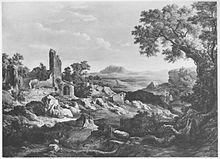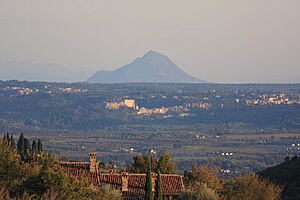Mount Soratte
| Mount Soratte | ||
|---|---|---|
|
View from the north |
||
| height | 691 m slm | |
| location | Metropolitan city of Rome , Lazio region , Italy | |
| Coordinates | 42 ° 15 ′ 0 ″ N , 12 ° 30 ′ 0 ″ E | |
|
|
||
The Monte Soratte (Latin mons Soracte ) is a stand-alone mountain 691 meters high in the Tiber Valley , which is visible from a great distance. It is located 52 km north of Rome in the Lazio region and about eight kilometers southeast of Civita Castellana . Geologically it belongs to the Sabine Mountains on the other side of the Tiber .
The elevation, consisting essentially of limestone and shimmering white in the sunshine, has already been described in poems by Virgil and Horace . Horace praises the sight of the mountain covered with snow in winter ( vides ut alta sta nive candidum Soracte?, Carm. I. 9), while Virgil names Apollo as the patron god of the mountain. A temple of Apollo on the summit was never proven. The rite of the hirpi sorani is said to be related to the wolves at Soracte . They were members of a specific local family who could walk barefoot over hot coals without getting burned.

In fact, he was dedicated to Dis Pater and the gods of the underworld.
At the foot of the east side of the mountain there is an abandoned limestone quarry.
Just a little below the summit is a monastery that was moved here from the summit in 1835. This monastery of San Silvestro was founded in 748 by Karlmann , the son of Karl Martell , the altar in the church ruins still shows fragments of sculptures from that time. Until today the monastery was used by the Trinitarian order .
The town of Sant'Oreste at the southeast end of the ridge owes its name to a modification of the original name of the church, which was dedicated to the local patron Edistus . In the city palazzo there is a processional cross from the 11th century in Byzantine style (see: Roman Quarterly Writing, 1905, Archeology).
The area around Monte Soratte is a nature reserve . Five marked hiking trails allow the visitor a comprehensive exploration. Also worth seeing are discovered 1920-1940 and developed Karst - caves .
From 1937, Benito Mussolini had a bunker built for the military leadership in Monte Soratte. After the armistice of Cassibile it was used by Albert Kesselring and his command authority from September 1943 . After the armistice and the extensive occupation of Italy by the German Wehrmacht ( Axis case ), Kesselring headed the operations in Italy as "Commander in Chief Southwest" ( Army Group C ).
After the war, the bunker was used, among other things, as an ammunition depot. In 1967 the construction of a nuclear shelter began in parts of the facility , but it was canceled in 1972 for unknown reasons. The Italian government gave up the bunker completely in 2008. Today the association Associazione Bunker Soratte takes care of the facility and also offers guided tours. In one part of the bunker, the Istituto Nazionale di Geofisica e Vulcanologia maintains an earthquake control room .
See also
Footnotes
- ↑ Strabon Geographika 5,2,9; Pliny , Naturalis historia 7.19. Mika Rissanen: The Hirpi Sorani and the Wolf Cults of Central Italy
- ↑ Homepage of the Bunker Soratte Association
- ↑ Comprehensive description of the bunker system on bunkerdiroma.it ( Memento of the original from March 4, 2016 in the Internet Archive ) Info: The archive link has been inserted automatically and has not yet been checked. Please check the original and archive link according to the instructions and then remove this notice. (Italian)
Web links
- Panoramic view from Monte Soratte (and more photos of the mountain) (Italian)
- Riserva naturale Monte Soratte - Monte Soratte nature reserve (Italian / English)
- Le grotte carsiche del Monte Soratte (Italian)

